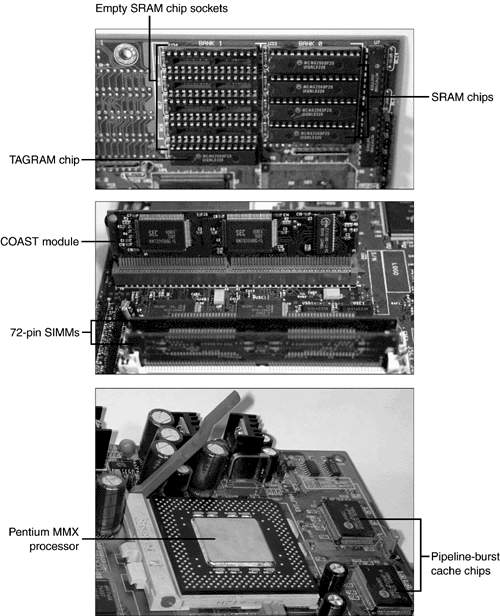Cache RAM and Main Memory
| < Day Day Up > |
| As you learned in Chapter 4, "The Motherboard and CPU," CPUs with Level 1 (L1) and/or Level 2 (L2) cache RAM perform RAM-bound operations much more quickly than CPUs that lack cache. There are two reasons why cache RAM helps the CPU perform RAM-bound operations faster:
Because programs and other processes performed by the CPU often use the same section of memory several times before they need to access a new section of memory, checking cache RAM first for information enables a CPU to perform tasks more quickly than if it checked main memory every time. In most situations, the memory section needed by the CPU is stored in cache memory, so the CPU can reuse it. The order in which the CPU accesses memory is L1 cache , then L2 cache (if necessary), L3 cache (if present, used mostly on server processors such as the Intel Itanium family) and finally, main memory (if necessary). This process is detailed here:
Locations for Level 2 CacheL2 cache is built into Pentium II and newer processors (see Chapter 4 for details), but is located on the motherboard of most Pentium and Pentium-class (Socket 4, 5, or 7) processors. Table 7.8 lists the types of L2 cache chips used on Pentium-class motherboards and their typical locations, which are pictured in Figure 7.9. Figure 7.9. L2 cache memory on Pentium-class motherboards might be provided by socketed SRAM chips (top), a COAST (Cache On A STick) module (middle), or surface-mounted pipeline-burst cache chips (bottom). Table 7.8. Level 2 Cache Types and Uses
Locations for L3 CacheThe only current PC processors with built-in L3 cache at this writing are the Intel Itanium family of processors, which are used in very high-performance servers. Some versions of the Intel Xeon used in servers and workstations, and the Intel Pentium 4 Extreme Edition used in high-performance PCs. The rare K6-III processor, which used the same Socket 7 as the Intel Pentium MMX, was the first PC processor to have both L1 and L2 cache onboard. When it was plugged into a motherboard that had onboard cache (as described in the previous section), the onboard cache was treated as L3 cache. Upgrading Cache RAMYou can upgrade the L2 cache on a Pentium-class system by installing additional SRAM cache chips or a COAST module or by installing a motherboard with integrated pipeline-burst cache chips. To upgrade the cache on newer systems, replace the processor with a model with more L2 cache.
|
| < Day Day Up > |
EAN: N/A
Pages: 310
